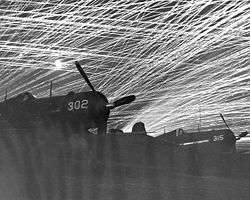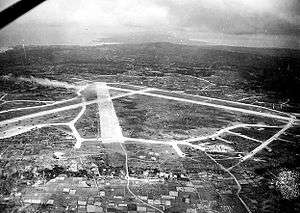Yontan Airfield
| Yontan Airfield Yontan Air Base Yontan Auxiliary Airfield | |
|---|---|
| Okinawa, Ryukyu Islands, Japan | |
|
A view of Yontan Air Field looking northeast in 1945 with the East China Sea in the background | |
| Coordinates | 26°23′36.83″N 127°44′48.12″E / 26.3935639°N 127.7467000°E |
| Type | Military airfield |
| Site information | |
| Controlled by |
United States Air Force United States Navy United States Marine Corps |
| Site history | |
| Built | 1944 |
| Built by | Imperial Japanese Army |
| In use | 1945–2006 |
Yontan Airfield (also known as Yomitan Auxiliary Airfield) is a former military airfield on Okinawa, located Yomitan, Okinawa Village on the Okinawa western coast. It was closed in July 1996 and turned over to the Japanese government in December 2006. Today it is home to the Yomitan Village Office and community complex, including baseball fields, running tracks, and community facilities.[1]
History

Yontan (Yomitan) Airfield was originally established by Imperial Japanese Army in 1944 as Kita Airfield (北飛行場 Kita Hikōjō). During the Battle of Okinawa on April 1, 1945, United States Marine Corps and United States Army forces seized the airfield on the first day of the landing. It was quickly repaired and became the first airfield on Okinawa to be used by the American forces. Later, it was developed into a major American base for Army, Marine, and Navy aircraft. Boeing B-29 Bockscar landed at Yomitan after the successful atomic bombing of Nagasaki.
It was at Yontan that the American forces first found copies of the Yokosuka MXY-7 "Ohka" rocket-propelled kamikaze aircraft. It was a manned flying bomb that was usually carried underneath a Mitsubishi G4M "Betty", Yokosuka P1Y Ginga "Frances" (guided Type 22) or planned Heavy Nakajima G8N Renzan "Rita" (transport type 43A/B) bomber to within range of its target; on release, the pilot would first glide toward the target and when close enough he would fire the Ohka's rocket engine and guide the missile towards the ship that he intended to destroy. The final approach was almost unstoppable (especially for Type 11) because the aircraft gained tremendous speed. Seven US ships were damaged or sunk by Ohkas throughout the war.
Major USAAF units assigned to Yontan
- Headquarters, Seventh Air Force, July 12, 1945 – January 1, 1946
- Headquarters, VII Bomber Command, July 1945 – March 1946
|
|

In addition to the USAAF units, Yontan Airfield hosted several Naval and Marine Corps air squadrons equipped with F4U Corsairs, PBY Catalinas and F6F Hellcats.
- Eighth Air Force was reassigned to Mac Dill AAF, Florida on June 7, 1946. All assigned units in the Pacific were reassigned to Twentieth Air Force that date.
B-32 Dominator
The 312th Bomb Group, 386th Bomb Squadron was the sole USAAF squadron that flew the Consolidated B-32 Dominator in combat. Following the dropping of the atomic bombs, in August 1945, the squadron was ordered to move to Okinawa from the Philippines, where the squadron flew several combat missions over Japan. These combat missions were flown in spite of a de facto cease-fire that had been called following the bombing of Nagasaki. During this time, the B-32s flew mainly photographic reconnaissance missions, most of which were unopposed. However, on August 17, a group of four B-32s flying over Tokyo were fired on by radar-directed flak and were attacked by Japanese fighters. The American aircraft escaped with only minor damage, claiming one confirmed fighter kill and two probables. During a reconnaissance mission over Tokyo on August 18, serials 42-108532 and 42-108578 were attacked by Japanese fighters. The American gunners claimed two kills and one probable, but 578 was badly shot up and one of her crew was killed with two being injured. That was to prove to be the last combat action of World War II.
The last Dominator mission of the war was flown by four B-32s on August 28 in a reconnaissance mission to Tokyo. The mission was a disaster, although not because of any enemy action. 42-108544 lost an engine on takeoff and skidded off the runway. All 13 men aboard perished when the aircraft exploded and burned. On the way back from the target, 42-108528 lost power on two of its four engines. The plane's pilot ordered the crew to bail out, but two men were killed.
Postwar use
After 1947, there were no permanently assigned units to Yontan, and the base was used as auxiliary for Kadena Air Base until the mid-1950s. Afterward it was placed in auxiliary reserve status.
In June 1948, the 170th Airway and Air Communications Service (AACS) Squadron was activated at Yontan, to provide air traffic control and communications support for USAF units in Okinawa. Shortly after the 170th redesignated as 1962d AACS Squadron. The unit moved to Kadena AB and redesignated as 1962d AACS Group (later, Communications Group) on 18 February 1955.
By 1950, Yontan was redesignated as a parachute drop training facility due to its runways not feasible for large/jet aircraft operations. By that time, local residents were started farming at the airfield with the tacit permission of the Air Force, there were no fences installed on the base boundaries except administrative area. Since the parachute drop trainings were first begun, 33 serious off range drop accidents occurred including the death of a girl on 2 August 1950 when a fuel tank fell into private house, and an 11 June 1965 accident in which a trailer landed off target crushing a 10-year-old girl, who was playing in the family yard.
From 1969 through the early 70's special services from Kadena AB used Yomitan as an Air Force Aeroclub training base. With six Cessna 150s based there flying seven days a week.
With the Okinawa reversion in 1972, the Government of Japan (GOJ) has concurrently provide the airfield as Yomitan Auxiliary Airfield (FAC 6027) for the USFJ requirements.[2]
Under the agreement of the 16th U.S.-Japan Security Consultative Committee in 1976, 250.78 acres of land at eastern portions of the airfield were partially returned to the GOJ in 3 release actions; 0.48 acres were released on 14 May 1977, 0.19 acres were released on 31 May 1977, and 250.11 acres were released on 30 April 1978. The remainder approximately 191 acres were transferred from Fifth Air Force to the control of Commander Fleet Activities, Okinawa (COMFLEACTS Okinawa) on 27 July 1978. In addition, control of the Yomitan Auxiliary Airfield passed from COMFLEACTS Okinawa to Commanding General Marine Corps Base, Camp Butler on 9 October 1980.
The last parachute drop training was conducted at Yomitan on 19 July 1996. Under the agreement of SACO Final Report, the training relocated to Ie Jima Auxiliary Airfield (FAC 6005), Yomitan retained as an electromagnetic interference restriction for HF/DF operations at Sobe Communication Site. With the completion of the functional relocation of Sobe Communication Site into Camp Hansen, Yomitan Auxiliary Airfield was completely returned to the GOJ and landowners in December 2006.
See also
References
- ↑ http://www.vill.yomitan.okinawa.jp/
- ↑ Minutes of the 251st Meeting, Joint Committee established by Article XXV of the Status of Forces Agreement (PDF). Ministry of Foreign Affairs, Government of Japan, 15 May 1972, pp. 82-84.
![]() This article incorporates public domain material from the Air Force Historical Research Agency website http://www.afhra.af.mil/.
This article incorporates public domain material from the Air Force Historical Research Agency website http://www.afhra.af.mil/.
- Maurer, Maurer (1983). Air Force Combat Units Of World War II. Maxwell AFB, Alabama: Office of Air Force History. ISBN 0-89201-092-4.
- www.pacificwrecks.com
- Harding, Stephen, (1993), Flying Terminated Inventory, Wings Magazine, April 1993 edition
External links
| Wikimedia Commons has media related to Yontan Airfield. |
